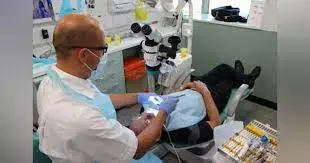- Home
- Medical news & Guidelines
- Anesthesiology
- Cardiology and CTVS
- Critical Care
- Dentistry
- Dermatology
- Diabetes and Endocrinology
- ENT
- Gastroenterology
- Medicine
- Nephrology
- Neurology
- Obstretics-Gynaecology
- Oncology
- Ophthalmology
- Orthopaedics
- Pediatrics-Neonatology
- Psychiatry
- Pulmonology
- Radiology
- Surgery
- Urology
- Laboratory Medicine
- Diet
- Nursing
- Paramedical
- Physiotherapy
- Health news
- Fact Check
- Bone Health Fact Check
- Brain Health Fact Check
- Cancer Related Fact Check
- Child Care Fact Check
- Dental and oral health fact check
- Diabetes and metabolic health fact check
- Diet and Nutrition Fact Check
- Eye and ENT Care Fact Check
- Fitness fact check
- Gut health fact check
- Heart health fact check
- Kidney health fact check
- Medical education fact check
- Men's health fact check
- Respiratory fact check
- Skin and hair care fact check
- Vaccine and Immunization fact check
- Women's health fact check
- AYUSH
- State News
- Andaman and Nicobar Islands
- Andhra Pradesh
- Arunachal Pradesh
- Assam
- Bihar
- Chandigarh
- Chattisgarh
- Dadra and Nagar Haveli
- Daman and Diu
- Delhi
- Goa
- Gujarat
- Haryana
- Himachal Pradesh
- Jammu & Kashmir
- Jharkhand
- Karnataka
- Kerala
- Ladakh
- Lakshadweep
- Madhya Pradesh
- Maharashtra
- Manipur
- Meghalaya
- Mizoram
- Nagaland
- Odisha
- Puducherry
- Punjab
- Rajasthan
- Sikkim
- Tamil Nadu
- Telangana
- Tripura
- Uttar Pradesh
- Uttrakhand
- West Bengal
- Medical Education
- Industry
Optical detection of endodontic infection using bacterial autofluorescence may improve success of root canal treatment

Optical detection of endodontic infection using bacterial autofluorescence may improve the success of root canal treatment suggests a new study published in the Journal Of Dentistry
For successful root canal treatment (RCT), it is essential to objectively assess the presence and activity of bacteria in the root canal system. However, current methods rely on subjective observations of root canal exudates. This study aimed to confirm whether real-time optical detection using bacterial autofluorescence can evaluate endodontic infection status by assessing the red fluorescence (RF) detected from root canal exudates.
During RCT, endodontic paper points were used to collect root canal exudates scored using conventional organoleptic tests to assess the severity of root canal infections. RF on the paper points was assessed using quantitative light-induced fluorescence (QLF) technology. RF intensity and area from the paper points were quantified, and their correlations with infection severity were assessed using their organoleptic scores. The oral microbiome composition of RF samples was compared with non-red fluorescent (non-RF) samples.
Results
The RF detection rate was nil and >98% in the non-infectious and severe groups. The RF intensity and area significantly increased with infection severity (p<0.001) and showed strong correlations with organoleptic scores (r=0.72, 0.82, respectively). The diagnostic accuracy for detecting root canal infection using RF intensity was good to excellent (AUC = 0.81−0.95) and increased with infection severity. The microbial diversity of the RF samples was significantly lower than that of the non-RF samples. Gram-negative anaerobic bacteria such as Prevotella and Porphyromonas were more predominant in RF samples.
Optical detection using bacterial autofluorescence can objectively evaluate endodontic infection status in real-time by assessing the RF of endodontic root canal exudates. This real-time optical technology can be utilised to detect endodontic bacterial infection without conventional incubation, allowing clinicians to determine the endpoint of chemomechanical debridement and increase the positive outcomes of RCTs.
Keywords: Diagnostic systems; Endodontic infection; Optical detection; Quantitative light-induced fluorescence; Red fluorescence
Reference:
Eun-Song Lee, Elbert de Josselin de Jong, Euiseong Kim, Baek-Il Kim,
Real-time optical detection of endodontic infection using bacterial autofluorescence,
Journal of Dentistry, Volume 136, 2023, 104600, ISSN 0300-5712, https://doi.org/10.1016/j.jdent.2023.104600.
(https://www.sciencedirect.com/science/article/pii/S0300571223001860)
Keywords:
Optical, detection, endodontic, infection, using, bacterial, autofluorescence, improve, success, root canal, treatment, Eun-Song Lee, Elbert de Josselin de Jong, Euiseong Kim, Baek-Il Kim, Journal of Dentistry
Dr. Shravani Dali has completed her BDS from Pravara institute of medical sciences, loni. Following which she extensively worked in the healthcare sector for 2+ years. She has been actively involved in writing blogs in field of health and wellness. Currently she is pursuing her Masters of public health-health administration from Tata institute of social sciences. She can be contacted at editorial@medicaldialogues.in.
Dr Kamal Kant Kohli-MBBS, DTCD- a chest specialist with more than 30 years of practice and a flair for writing clinical articles, Dr Kamal Kant Kohli joined Medical Dialogues as a Chief Editor of Medical News. Besides writing articles, as an editor, he proofreads and verifies all the medical content published on Medical Dialogues including those coming from journals, studies,medical conferences,guidelines etc. Email: drkohli@medicaldialogues.in. Contact no. 011-43720751


